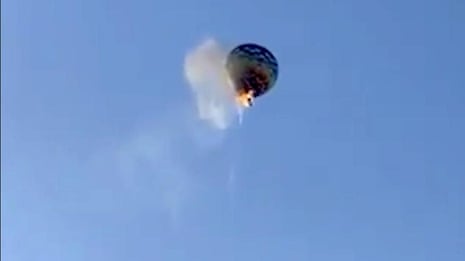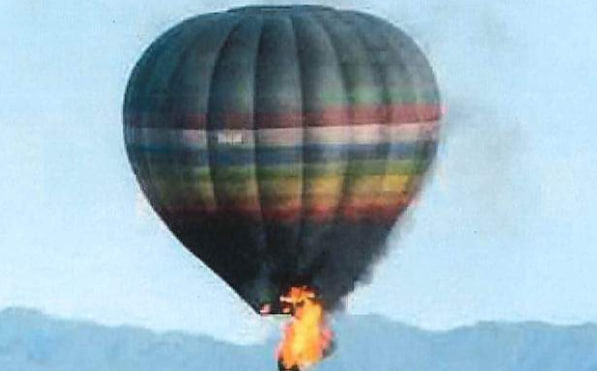Hot air ballooning is often described as one of the most peaceful ways to take in sweeping views of landscapes from above. The slow, graceful movement of the balloon, combined with the quiet of the open sky, makes it a favorite activity for adventure seekers and sightseeing enthusiasts alike. However, while the majority of hot air balloon flights are completed safely, there have been rare occasions when tragic accidents have occurred.

The 2013 Luxor, Egypt Balloon Tragedy
One of the most devastating accidents in hot air ballooning history took place in Luxor, Egypt, in February 2013. The balloon was carrying a group of 21 tourists on a morning sightseeing trip over the ancient city, a destination famous for its temples, tombs, and the nearby Nile River.
Shortly after takeoff, a fire broke out on board. The balloon descended rapidly from an estimated height of about 300 meters (1,000 feet). Nineteen of the passengers lost their lives, making it one of the deadliest hot air balloon incidents in recorded history.
Eyewitness footage from the ground captured the final moments of the balloon’s descent, images that would later be used in investigations. Authorities examined the accident to determine its cause, and the tragedy prompted renewed discussions about safety protocols in Egypt’s balloon tourism sector.

The 2016 Lockhart, Texas Disaster
Another highly publicized tragedy occurred in Lockhart, Texas, in July 2016. A hot air balloon carrying 16 passengers struck a high-voltage power line. The contact with the line caused a fire that led to the balloon’s crash.
Tragically, there were no survivors, making it the deadliest hot air balloon accident in United States history. In the aftermath, the National Transportation Safety Board (NTSB) conducted a thorough investigation into the crash. Findings from the inquiry led to calls for stricter regulations governing commercial balloon pilots, including medical certifications similar to those required for airplane pilots.
This incident remains a pivotal moment in U.S. aviation safety history, underscoring the potential risks of balloon flights and the importance of regulatory oversight.
The 2007 Surrey, British Columbia Crash
In May 2007, a hot air balloon accident in Surrey, British Columbia, Canada, ended in tragedy. The balloon drifted into a power line shortly after takeoff, causing a fire. The balloon descended rapidly, resulting in the deaths of two passengers and injuries to eleven others.
Onlookers, some of whom were family members of those on board, captured the incident on camera. The footage, later broadcast by news outlets, revealed how quickly a routine sightseeing trip could turn dangerous.
Investigators examined contributing factors, such as weather conditions, pilot decision-making, and the balloon’s proximity to power lines during its ascent. The crash led to discussions in Canada about safety procedures, pre-flight inspections, and the positioning of launch sites relative to hazards like electrical infrastructure.

Lessons from Past Tragedies
While these three accidents stand out for their severity, they also share common themes that have shaped the modern approach to hot air balloon safety:
-
Importance of Pre-Flight Inspections
Thorough equipment checks before each flight are crucial. This includes examining the balloon’s envelope, burner, and basket for wear, leaks, or any other signs of malfunction. -
Weather Awareness
Pilots must have accurate, up-to-date weather information before taking off. Conditions such as strong winds, sudden temperature changes, or storms can significantly increase risks. -
Avoidance of Obstacles
Power lines and other aerial obstructions are among the most dangerous hazards for balloon flights. Careful planning of the flight path is essential to avoid potential contact. -
Training and Certification
Highly trained pilots, with certification and ongoing education, are key to maintaining safety standards. Training includes not only flying skills but also emergency procedures and passenger safety briefings. -
Regulatory Oversight
Incidents have led to stricter regulations in various countries, including medical fitness requirements for pilots, enhanced safety protocols, and increased inspections for commercial balloon operators.
Advances in Ballooning Safety
Despite these tragedies, hot air ballooning remains statistically safer than many other forms of aviation and adventure tourism. Continuous technological improvements have further reduced risks:
-
Better Materials: Modern balloons use flame-resistant fabrics and stronger basket construction.
-
Improved Burners: Newer burner designs improve fuel efficiency and reduce the risk of accidental ignition.
-
GPS and Tracking: Advanced GPS systems allow for more precise navigation and help pilots avoid dangerous areas.
-
Enhanced Training: Many countries now require more flight hours, simulator training, and recurrent certifications for pilots.
These advancements aim to ensure that such incidents become even rarer in the future.
Balancing Adventure with Safety
For many, hot air ballooning is a bucket-list experience. Floating over vineyards, deserts, mountains, or historical landmarks offers a unique perspective that can’t be matched by other forms of flight. The sense of peace and wonder that comes from drifting silently above the landscape is what draws people to the sport.
Still, these accidents remind passengers and operators alike of the importance of prioritizing safety over spectacle. Travelers are encouraged to choose licensed operators, ask about the company’s safety record, and follow all pre-flight instructions provided by the crew.
Conclusion
The 2013 Luxor disaster, the 2016 Lockhart tragedy, and the 2007 Surrey crash stand as somber reminders of the potential dangers in hot air ballooning. Each incident was captured on camera, leaving a lasting visual record of the risks involved when safety measures fail or unforeseen hazards occur.
Yet, it’s important to recognize that these are rare events in the broader history of ballooning. With modern safety technologies, experienced pilots, and strict regulations, the vast majority of hot air balloon rides conclude without incident, offering passengers unforgettable moments in the sky.
As the industry continues to evolve, the lessons learned from past tragedies will remain vital in ensuring that the beauty and thrill of hot air ballooning can be enjoyed as safely as possible for years to come.
